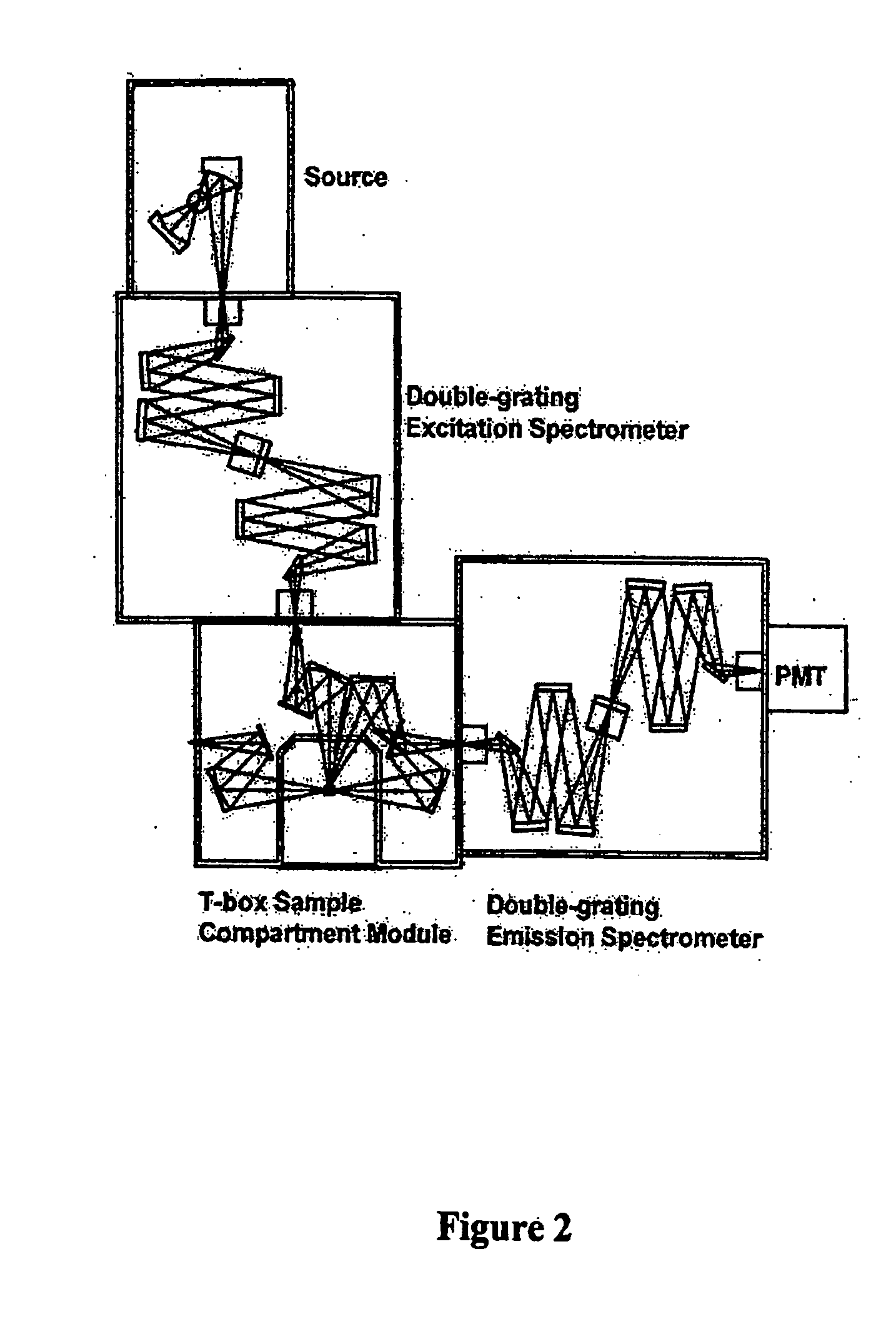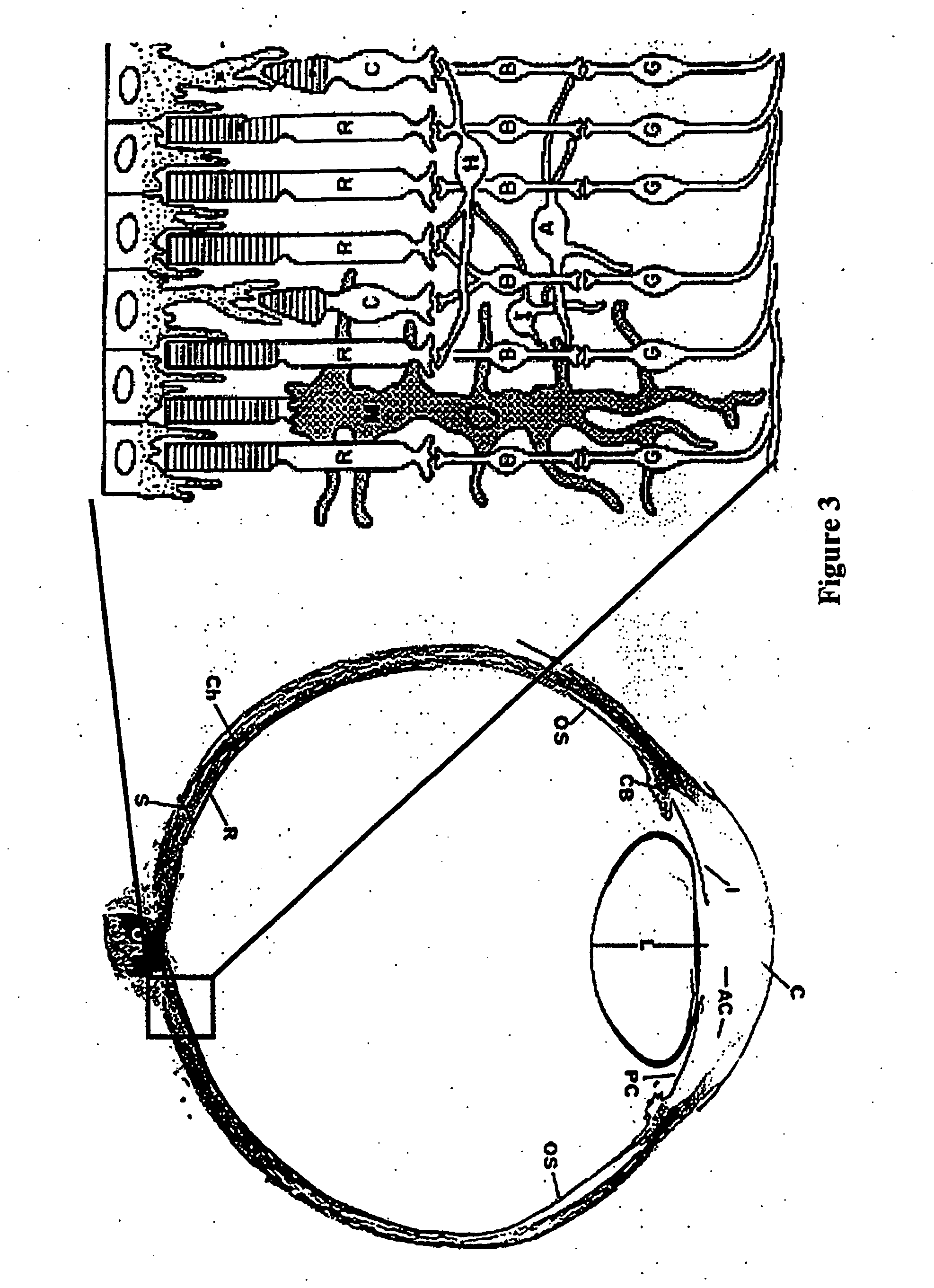Detection and analysis of ophthalmically-relevant fluorescent molecules
a fluorescent and fluorescent technology, applied in the field of ophthalmic conditions, can solve the problems of severe damage to the central vision, gradual loss of vision, and vision loss, and achieve the effect of lowering the level of serum retinol
- Summary
- Abstract
- Description
- Claims
- Application Information
AI Technical Summary
Benefits of technology
Problems solved by technology
Method used
Image
Examples
example 1
Fluorescence Analysis of A2E and A2PE-H2 in Tissue Extracts
[0209] A. Preparing the Tissue Extract. Eyes are enucleated from euthanized mice and hemisected to reveal retina and retinal pigment epithelium (RPE). Retina is removed cleanly from underlying RPE with dissecting forceps. RPE is brushed from the underlying scleral tissue into 100-200 μl of PBS, pH 7.2 using a #2 camel hair brush. RPE cells are aspirated from the eyecup using a micro-pipette. Human post-mortem tissue is processed in a similar fashion. Tissues are homogenized by hand using a Duall glass-glass homogenizer following the addition of 500 μl chloroform / methanol (2:1, v / v). Samples are transferred to a borosilicate tube and lipids are extracted into 1 ml of chloroform. The organic extract is washed with 1 ml PBS, pH 7.2 and the samples are centrifuged at 3,000×g, 10 min. The chloroform phase is decanted and the aqueous phase is re-extracted with another 1 ml of chloroform. Following centrifugation, the chloroform p...
example 2
Fluorescence Analysis of A2PE-H2 in Whole Retina Explant
[0211] A. Preparing the Whole Retina and Retinal Epithelium Explants. Eyes are enucleated from euthanized mice and hemisected to reveal retina and retinal pigment epithelium (RPE). Retina is removed cleanly from underlying RPE with dissecting forceps. The remaining RPE / sclera are saved and stored separately. Samples of post-mortem human retina tissue are obtained as described above. The retina and RPE / sclera samples are moistened with PBS, pH 7.2 and placed separately into a solid phase sample mount so that the sample is oriented perpendicular to the incoming light (FIG. 8A). Emission spectra are obtained from the samples as described (FIG. 10A).
[0212] B. Fluorescence Analysis of A2PE-H2. Front face fluorescence emission from retina samples are acquired at 22.5° relative to the incoming light. Excitation light is set to 480 nm and emission spectra are acquired from 500 nm to 650 nm using a Jobin-Yvon Fluorolog 3 spectrofluoro...
example 3
Fluorescence Analysis of A2E and A2PE-H2 in the Intact Eye of a Live Animal
[0213] A. Preparing the Intact Eye of a Live Animal. Live mice are treated with a mydriatic (e.g., atropine) in order to dilate the pupil. The mice are anesthetized and placed onto a modified sample cell carriage such that the right or left eye is oriented toward the incoming light. See FIG. 8b.
[0214] B. Fluorescence Analysis of A2E and A2PE-H2 in the Intact Eye of a Live Animal. Front face fluorescence emission from intact eyes are acquired at 22.5° relative to the incoming light. Three analyses are performed: 1) Excitation light is set to 450 nm and emission spectra are acquired from 460 nm to 650 nm; 2) Excitation light is set to 480 nm and emission spectra are acquired from 490 nm to 650 nm; 3) Excitation light is set to 500 nm and emission spectra are acquired from 510 nm to 700 nm;
[0215] All data are acquired using a Jobin-Yvon Fluorolog 3 spectrofluorometer. Bandpass filters (slit widths) are adjust...
PUM
 Login to View More
Login to View More Abstract
Description
Claims
Application Information
 Login to View More
Login to View More - R&D
- Intellectual Property
- Life Sciences
- Materials
- Tech Scout
- Unparalleled Data Quality
- Higher Quality Content
- 60% Fewer Hallucinations
Browse by: Latest US Patents, China's latest patents, Technical Efficacy Thesaurus, Application Domain, Technology Topic, Popular Technical Reports.
© 2025 PatSnap. All rights reserved.Legal|Privacy policy|Modern Slavery Act Transparency Statement|Sitemap|About US| Contact US: help@patsnap.com



